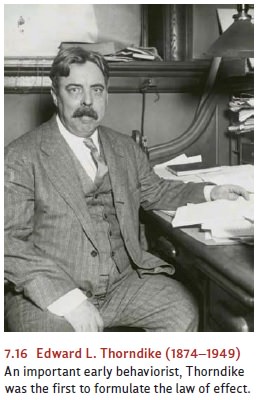Chapter: Psychology: Learning
Instrumental Conditioning
INSTRUMENTAL CONDITIONING
Habituation and classical
conditioning are both general forms of learning that are rel-evant to many
species (including, of course, humans) and many different responses (including
a variety of overt behaviors, a range of subjective feelings, and a broad set
of bodily responses). An equally important type of learning is instrumental conditioning (also called operant conditioning). This form of
learning involves behaviors that aren’t triggered automatically by some
stimulus. Instead, instrumental conditioning is con-cerned with behaviors
initiated by—and presumably under the control of—the organ-ism itself. In other
words, while classical conditioning essentially involves the creation of new
reflexes, instrumental conditioning involves the learning of new voluntary
behaviors.
Thorndike and the Law of Effect
The experimental study of
instrumental conditioning began a century ago and was sparked by the debate
over Darwin’s theory of evolution by natural selection. Supporters of Darwin’s
theory emphasized the continuity among species, both living and extinct:
Despite their apparent differences, a bird’s wing, a whale’s fin, and a human
arm, for example, all have the same basic bone structure; this similarity makes
it plausi-ble that these diverse organisms all descended, by a series of
incremental steps, from common ancestors. But opponents of Darwin’s theory
pointed to something they per-ceived as the crucial discontinuity among
species: the human ability to think and reason—an ability they claimed animals
did not share. Didn’t this ability, unique to our species, require an
altogether different (non-Darwinian) type of explanation?
In response, Darwin and his
colleagues argued that there is, in fact, considerable continuity of mental
prowess across the animal kingdom. Yes, humans are smarter in some ways than
other species; but the differences might be smaller than they initially

seem. In support of this idea,
Darwinian naturalists collected stories about the intellec-tual achievements of
various animals (Darwin, 1871). These stories painted a flattering picture, as
in the reports of cunning cats that scattered breadcrumbs on the lawn to lure
birds into their reach (Romanes, 1882). In many cases, however, it was hard to
tell whether these reports were genuine or just bits of folklore. Even if they
were genuine, it was unclear whether the reports had been polished by the
loving touch of a proud pet owner. What was needed, therefore, was more
objective and better documented research—research that was made possible by a
method described in 1898 by Edward L. Thorndike (1874–1949; Figure 7.16).
Related Topics